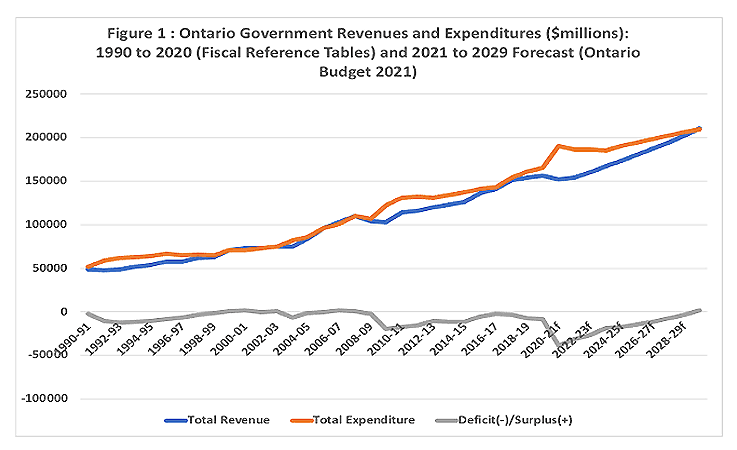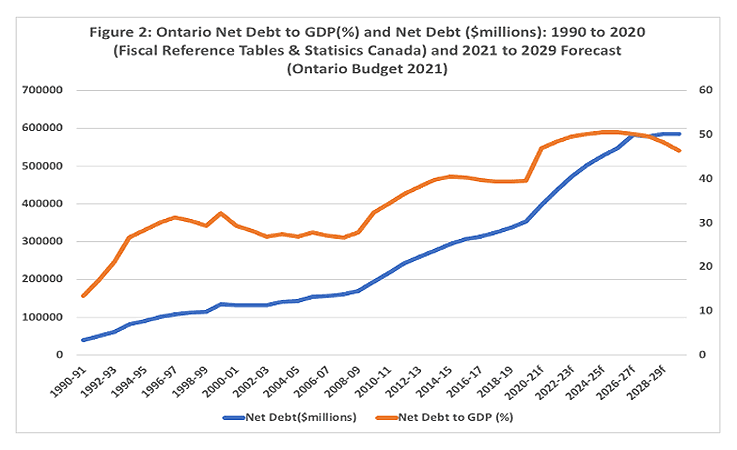Ford government presiding over massive growth of debt and debt interest costs

Ontario Finance Minister Peter Bethlenfalvy has presented the Ford government’s 2021 budget, which deals primarily with continuing the response to COVID-19 both in terms of the health response and economic damage and recovery. Pandemic funding and support will continue to flow for the next couple of years, and along with the $20.1 billion of support in 2020-21, there will be an additional $6.7 billion and $2.8 billion in the subsequent two years before the government anticipates a return to “normal” spending.
For 2020-21, the deficit is estimated at $38.5 billion and for the 2021-22 fiscal year it’s expected to be $33.1 billion and then $27.7 billion the year after. However, the government has proposed a sort of general direction for getting to a balanced budget—but it’s very long-term. Deficits are projected to fall until 2029-30 when there will be a $900 million surplus, assuming projections for economic growth and spending take shape (and the world should last so long).
To properly appreciate this view of future fiscal history, the first chart below presents the numbers for total revenues, total expenditures and the deficit to 2029-30, but also puts them into historical perspective by going back to 1990.

The second chart repeats the historical perspective in its presentation of the future for the net debt and the net debt-to-GDP ratio. (The numbers are from the Fiscal Reference Tables for the 1990 to 2019 period with GDP numbers from Statistics Canada and the Ontario 2021 Budget for the years after up until 2029.)

When viewed through a historical lens, it appears Ontario is nowhere near addressing the long-term structural gap in its finances. If these projections come to pass, Ontario will have run since 2008-09 a total of 21 budget deficits before reaching balance in 2029-30, resulting in accumulated deficits of $284.9 billion. By 2029, Ontario will take in $210.1 billion in nominal revenues (up 35 per cent from 2019-20) and then spending $209.1 billion (up 27 per cent from the same reference point). It would appear the game plan is the traditional 21st century Ontario approach to fiscal balance whereby deficits open up quickly during downturns and the gap then closes by slowing expenditure growth and waiting for revenues to catch up. In the meantime, the debt grows.
The result (as illustrated in the first chart) is a net debt that will rise from $397.2 billion in 2020-21 to reach an astounding $585.3 billion by 2029-30. And a net debt-to-GDP ratio that will remain just short of 50 per cent for an entire decade. The levelling off of the total net debt and the arrest of a rising net debt-to-GDP ratio after 2025-26 is really wishful thinking based on the hopes of containing expenditure growth and rising revenues from an economy (which is expected to grow), which may or may not persist given periodic downturns aside from catastrophic shocks such as pandemics. The current low price of borrowed money is often advanced as a reason to not worry so much about debt, but as the stock of nominal debt rises so do debt service costs (in nominal terms) rise from $12.5 billion in 2021-21 to $20.6 billion in 2029-30, an increase of 65 per cent.
It indeed will be the roaring ’20s when it comes to the growth of net debt and debt service costs in Ontario. The province’s fastest-growing expenditure category from 2021 to 2029 will be debt service costs. The average annual growth rate for nominal health-care spending is expected to be 2.6 per cent—meaning real per-capita health-care spending will stay flat for a decade despite assurances that more will be spent on hospitals and long-term care. Education will grow at an annual average of 1.1 per cent, post-secondary education at 1.2 per cent, children and social at 0.6 per cent annually and interest on the debt at 5.1 per cent.
The true long-term cost of Ontario’s inability to reconcile spending with revenues, and its reliance on borrowed money, is rising debt interest costs over time, which leave fewer resources for the things that really matter such as health and education.
Author:
Subscribe to the Fraser Institute
Get the latest news from the Fraser Institute on the latest research studies, news and events.

